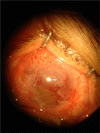5-Fluorouracil for the treatment of intraepithelial neoplasia and squamous cell carcinoma of the conjunctiva, and cornea
- PMID: 20689797
- PMCID: PMC2915867
- DOI: 10.2147/opth.s9709
5-Fluorouracil for the treatment of intraepithelial neoplasia and squamous cell carcinoma of the conjunctiva, and cornea
Abstract
Objective: To evaluate the efficacy and risks of complications of pulse dosing of topical 5-fluorouracil (5-FU) in the treatment of corneal intraepithelial neoplasia (CIN), and conjunctival squamous cell carcinoma (SCC).
Design: Prospective, noncomparative case series.
Participants: Fifteen patients with histological evidence CIN or SCC of the conjunctiva and cornea were identified by tumor biopsy.
Methods: All patients clinically evident of CIN, or SCC were evaluated, with maximum 30 months of follow-up were treated with pulsed dosing of 1% 5-FU. Treatment cycles were defined as four times per day for 4 days using the medication followed by 30 days without medication. The number of initial treatment was six cycles.
Results: The mean age of the 15 patients was 50.8 years (range 25-78 years). Excision biopsy proved seven cases as CIN, and eight cases as locally invasive SCC. All patients remained disease free with a mean follow-up of 14.53 months (range 6-30 months). Additional chemotherapy was given after the initial treatment cycles, only for one case. 5-FU caused mild temporary local irritation, but no long-term intraocular or extra ocular complications.
Conclusions: Adjuvant 1% topical 5-FU appears to be effective in the prevention of recurrence of conjunctival or corneal CIN and SCC after excision biopsy. Our results indicate that at least six cycles of topical 1% 5-FU is required to prevent local recurrence in the long term. It is well-tolerated and an effective method of treatment. No complications that would preclude use of our dose regimen were noted.
Keywords: chemotherapy; fluorouracil; neoplasia; treatment cycles.
Figures







Similar articles
-
5-Fluorouracil for the treatment of intraepithelial neoplasia of the conjunctiva and cornea.Ophthalmology. 2000 Dec;107(12):2190-5. doi: 10.1016/s0161-6420(00)00389-4. Ophthalmology. 2000. PMID: 11097594
-
Topical mitomycin C for extensive, recurrent conjunctival-corneal squamous cell carcinoma.Am J Ophthalmol. 2002 May;133(5):601-6. doi: 10.1016/s0002-9394(02)01400-9. Am J Ophthalmol. 2002. PMID: 11992855 Clinical Trial.
-
Topical chemotherapy for giant ocular surface squamous neoplasia of the conjunctiva and cornea: Is surgery necessary?Indian J Ophthalmol. 2018 Jan;66(1):55-60. doi: 10.4103/ijo.IJO_590_17. Indian J Ophthalmol. 2018. PMID: 29283124 Free PMC article.
-
Treatment of ocular surface squamous neoplasia with Mitomycin C.Br J Ophthalmol. 2010 May;94(5):555-8. doi: 10.1136/bjo.2009.168294. Br J Ophthalmol. 2010. PMID: 20447963 Review.
-
Treatment of advanced neuroendocrine tumours using combination chemotherapy with lomustine and 5-fluorouracil.Clin Endocrinol (Oxf). 2002 Aug;57(2):169-83. doi: 10.1046/j.1365-2265.2002.01589.x. Clin Endocrinol (Oxf). 2002. PMID: 12153595 Review.
Cited by
-
Utility of high-resolution anterior segment optical coherence tomography in the diagnosis and management of sub-clinical ocular surface squamous neoplasia.Eye Vis (Lond). 2019 Aug 27;6:27. doi: 10.1186/s40662-019-0152-3. eCollection 2019. Eye Vis (Lond). 2019. PMID: 31463333 Free PMC article.
-
AS-OCT Guided Treatment Of Diffuse Conjunctival Squamous Cell Carcinoma With Resection, Amniotic Membrane Graft And Topical Mitomycin C.Clin Ophthalmol. 2019 Nov 20;13:2269-2278. doi: 10.2147/OPTH.S229399. eCollection 2019. Clin Ophthalmol. 2019. PMID: 31819351 Free PMC article.
-
Topical 5-Fluorouracil 0.5% as primary treatment for Ocular Surface Squamous Neoplasia.Eur J Ophthalmol. 2025 Jan;35(1):352-356. doi: 10.1177/11206721241256687. Epub 2024 May 23. Eur J Ophthalmol. 2025. PMID: 38780319 Free PMC article.
-
Excision combined with ocular surface reconstruction followed by topical chemotherapy for ocular surface squamous neoplasia.Jpn J Ophthalmol. 2024 Nov;68(6):731-740. doi: 10.1007/s10384-024-01111-0. Epub 2024 Oct 2. Jpn J Ophthalmol. 2024. PMID: 39356385 Free PMC article.
-
Update in the Diagnosis and Management of Ocular Surface Squamous Neoplasia (OSSN).J Clin Med. 2025 Mar 3;14(5):1699. doi: 10.3390/jcm14051699. J Clin Med. 2025. PMID: 40095695 Free PMC article. Review.
References
-
- Lovieno A, Lambiase A, Moretti C, et al. Therapeutic effect of topical 5-fluorouracil in conjunctival squamous carcinoma is associated with changes in matrix metalloproteinases and tissue inhibitor of etalloproteinases expression. Cornea. 2009;28:821–824. - PubMed
-
- McLean IW, Burnier MN, Zimmerman LE, et al. Tumors of the Eye and Ocular Adnexa3rd seriesWashington, DC: Armed Forces Institute of Pathology; 199449–95.
-
- Pe’er J. Ocular surface squamous neoplasia. Ophthalmol Clin North Am. 2005;18:1–13. - PubMed
-
- Shields CL, Demirci H, Karatza E, et al. Clinical survey of 1643 melanocytic and nonmelanocytic conjunctival tumors. Ophthalmology. 2004;111:1747–1754. - PubMed
-
- Shields CL, Shields JA. Tumors of the conjunctiva and cornea. Surv Ophthalmol. 2004;49:3–24. - PubMed
LinkOut - more resources
Full Text Sources
Research Materials

